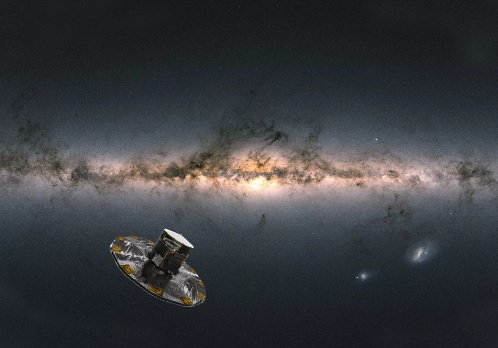Tech
Gaia mission finds ‘stellar earthquakes’ on new map of Milky Way

By
Southern Newsroom
| June 18, 2022

Phenomena observed in thousands of stars are associated with movements on the surface of each star. (Photo: ESA/Gaia/DPAC)
The European Space Agency’s (ESA) Gaia mission has released the third batch of data from a project that aims to produce the most comprehensive map of the Milky Way. Among the highlights discovered is the detection of “earthquakes” in thousands of stars in our galaxy.
These phenomena are marked by small movements on the surface of each star and are able to change the shape of the stars. “Starquakes teach us a lot about stars, especially their inner workings. Gaia opens a goldmine for massive star ‘asteroseismology’, said Connie Earths, a member of the ESA mission, in a statement.
Although the space enterprise was not designed to detect these “earthquakes,” it found vibrations even in stars that had rarely been seen before. The most recent theory is that these stars shouldn’t have any jolts, but detection has shown just the opposite.
In the largest 3D motion map of the Milky Way, the Gaia mission has captured the details of nearly 2 billion stars. Among them are information about the chemical composition, temperature, color, mass, age, and even the speed at which stars approach or move away from the Earth (radial velocity).
The mission’s astronomers also discovered the largest catalog of binary stars ever created, as well as special stellar subsets, such as those whose brightness changes over time. It also managed to obtain data on thousands of solar system objects, such as asteroids, moons and millions of galaxies and quasars outside the Milky Way.
Some stars discovered by Gaia contain more heavy metals than others. Although some of them are composed of primordial material, there are stars such as the Sun that are composed of matter enriched from previous stellar generations.
“Our galaxy is a beautiful melting pot of stars,” compares Alejandra Rechio-Blanco of the Côte d’Azur Observatory in France. For a specialist who collaborated with the Gaia team, this diversity is extremely important, because it tells us the history of the Milky Way.
Much of the information from the Gaia space observatory comes from recently published data from spectroscopy, a technique in which starlight is broken down into its component colors, much like a rainbow.
“By scouring the entire sky with billions of stars over and over again, Gaia is forced to make discoveries that other, more specialized missions would miss,” says Timo Prusti, Gaia Project Scientist at ESA. “That’s one of its strengths, and we can’t wait for the astronomical community to delve into our new data to learn more about our galaxy and its environs than we ever imagined.”
come back
all science

Amateur music guru. Lifelong coffee scholar. Zombieaholic. Pop culture junkie.
Tech
‘My power is really low’: NASA’s Mars Insight rover prepares to launch from the Red Planet
NASA Lander InSight He has delivered what may be his last message from Mars as he embarks on a historic mission to uncover the secrets of the Red Planet’s interior.
In November, the space agency warned that the probe could be running out of time as dust continued to condense and stifle InSight’s power.
“Spacecraft power generation continues to decline as windblown dust accumulates on solar panels,” NASA said in a statement. Update November 2. “The end is expected to come in the coming weeks.”
message shared NASA The InSight Twitter account tweeted on Monday: “My power is very low so this might be the last photo I can upload. Don’t worry about me: my time here has been productive and uneventful. If I can keep talking to my mission team, I will—but I will.” Subscribe here soon. Thank you for staying with me.”
My power is very low, so this might be the last photo I can upload. But don’t worry about me: my time here has been productive and uneventful. If I can keep talking to my mission team, I will, but I’ll sign here soon. Thank you for staying with me. pic.twitter.com/wkYKww15kQ
— NASA InSight (@NASAInSight) December 19, 2022
A geologist robot armed with a hammer and a seismograph first reached the barren expanse of Elysium Planitia in November 2018.
Since then, she has carried out geological excavations, taking the first measurements of earthquakes with a high-tech seismometer placed right on the surface of Mars.
Last month, the solar-powered car released an update to remind us of its time in space.
“I was lucky to live on two planets. Four years ago I made it safely to the second one, much to the joy of my family at first. Thanks to my team for taking me on this journey of discovery. I hope I can be proud of you.”
According to the published mission, Insight has measured more than 1,300 seismic events since it was published, and more than 50 of them had signals clear enough for the team to extract information about their location on Mars. Results.
The probe’s data also provided detailed information about Mars’ interior, liquid core, surprisingly variable remnants beneath the surface of an extinct magnetic field, climate and seismic activity.
old for Its launch in 2018NASA Chief Scientist Jim Green said the mission was “fundamental to understanding the origins of our solar system and how it became what it is today.”
NASA will not declare the mission complete until Insight confirms the arrival of two spacecraft orbiting Mars that are relaying their information back to Earth.
In 2018, the veteran rover announced the capabilities end of his 15 year stay Sending an incomplete photo of the Valley of Perseverance.
A severe dust storm darkened the sky around the solar-powered rover, shattering the sun and leaving behind a dark image with white spots due to camera noise. The transmission is interrupted before the complete image can be transmitted.

Amateur music guru. Lifelong coffee scholar. Zombieaholic. Pop culture junkie.
Tech
What’s new on February 7, 2023

Being very close companies, OPPO and OnePlus have decided to create a new partnership, with the latter being a pioneer in the market. It has become the representative of the best smartphones in the group, and this will be seen very soon.
Proving this, OnePlus has announced that it will have news soon. The following brand assets will be announced on February 7, 2023. We are talking about OnePlus 11 5G and Buds Pro 2.
In recent years, OnePlus has been showcasing new hardware in an attempt to find a new place in the market. The brand has not always seen its full potential, betting on mid-range or entry-level smartphones.
The situation is changing, and the novelty will go on sale in early 2023, February 7. It is on this day that the new OnePlus 11 5G will be presented with all the expected news. We definitely have the new Qualcomm Snapdragon 8 Gen 2 SoC here. There's still 16GB of storage left and 256GB of onboard storage.
It is expected that he will receive a 6.7-inch OLED display with a resolution of 1440p and a frequency of 120 Hz. In the field of photography, we will have an important change: a 50 MP main camera, a 48 MP ultra wide-angle camera and a 32 MP telephoto lens with 2x zoom. For selfies and video calls, you'll have a 16-megapixel camera.
The photography partnership with Hasselblad will continue with OnePlus for fine-tuning and some additions. This alliance has brought important results for the best smartphones of the brand, guaranteeing the best photos in any situation.
In addition to the new OnePlus 11 5G, another brand new feature is also expected to arrive at the event. We're talking about the Buds Pro 2, which are solidifying an audio commitment that's becoming more of a reality. The brand promises "rich stereo quality sound with crystal clear clarity".
Stays like this marked by the beginning of February, another important novelty will enter the market. OnePlus wants to reclaim its place, and that will be the brand's bet for years to come. OnePlus 11 5G and Buds Pro 2 take the first step in this direction.

Amateur music guru. Lifelong coffee scholar. Zombieaholic. Pop culture junkie.
Tech
New POCO Smartphone Seen in Certification May Debut Soon

According to information provided by Mukul Sharma, the unidentified POCO device can be identified by the model number 22127PC95I. Due to the fact that it was first seen online, the marketing name of this equipment is still a mystery.
POCO has not launched new mobile devices, including smartphones, to the market for some time now. On the other hand, several POCO smartphones such as POKO X5 and X5 Pro have been spotted on various certification sites, suggesting that the company will release these products soon. Today a new smartphone from the sub-brand xiaomi has been spotted on the BIS India website but the device does not have a name or any other details associated with it.
A new POCO device (model number 22127PC95I) has been included in the Indian BIS certification. POCO F5 has the model number 23013PC75I. #A LITTLE pic.twitter.com/NAFloP5Crt
— Mukul Sharma (@stufflistings) December 19, 2022
According to information provided by Mukul Sharma, the unidentified POCO device can be identified by the model number 22127PC95I. Due to the fact that it was first seen online, the marketing name of this equipment is still a mystery. It is possible that it will debut as a mid-range smartphone. The Bureau of Indian Standards (BIS) website, other than the model number of the smartphone, does not provide any additional information about the device. However, this seems to indicate that the product will be available in the Indian market very soon.
In other related news, POCO X5 5G has recently been seen on several certification sites including SIRIM in Malaysia, BIS in India and the US FCC. According to various sources, it is possible that this is a renamed or modified version Redmi Note 12 5Gwhich was recently released in China.

It is supposed to be equipped screen 6.67″ AMOLED display with 120Hz refresh rate and chipset Snapdragon 4 Gen 1 inside. Can run MIUI 13 based on android 12 and have LPDDR4x RAM in addition to UFS 2.2 storage. The front camera is rumored to be 8MP while the main rear camera will be 48MP with 2MP depth. May have the ability drums 5000 mAh and 33W fast charging support.
In addition POCO X5 Pro 5G has recently been seen on various sites dedicated to certification. The battery is said to have a capacity of 5000 mAh and can charge at 67W. It will come with MIUI 14 preinstalled and will support n5, n7, n38, n41, n77 and n78 network bands. 5G.
 Every day we bring you dozens of news from the world of Android in Portuguese. Follow us on Google News. Click here and then on “Subscribe”. Thank you! Every day we bring you dozens of news from the world of Android in Portuguese. Follow us on Google News. Click here and then on “Subscribe”. Thank you! |

Amateur music guru. Lifelong coffee scholar. Zombieaholic. Pop culture junkie.
-
World4 years ago
The Gabby Petito case. Brian Landry set up camp with his family after his girlfriend disappeared
-
Top News5 years ago
Tristan Thompson reacts to Khloé Kardashian’s new appearance
-
Economy2 years ago
Everything has been delivered. 10 Bugatti Centodieci are already in the hands of the owners
-
Top News5 years ago
TLC ‘sMothered’ recap: ‘Party curled up,’ boyfriend problem
-
Top News5 years ago
Alex Cooper hosts a solo podcast
-
Top News5 years ago
2021 Ford Bronco price: Here’s how much the 2-door and 4-door cost
-
Tech5 years ago
Fall Guys is supplying out a legendary costume and Kudos as an apology present
-
Top News5 years ago
Chiara de Blasio was ‘very cold’ during the arrest of the protest: witness












